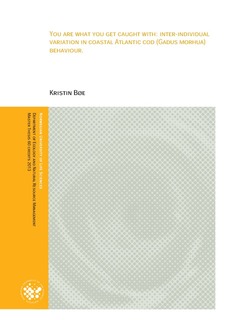You are what you get caught with : inter-individual variation in coastal Atlantic cod behaviour
Master thesis
Permanent lenke
http://hdl.handle.net/11250/187061Utgivelsesdato
2014-02-11Metadata
Vis full innførselSamlinger
- Master's theses (INA) [593]
Sammendrag
Consistent behavioural differences among individuals is a common phenomenon that has been demonstrated
for a wide range of taxonomical groups. Such behavioural differences are expected to have ecological and
evolutionary implications and has therefore received an increasing amount of attention during the past
decade.
This study applies acoustic telemetry to explore intra-population variation in coastal Atlantic cod behaviour.
Specifically, I explore whether consistent differences in cod (Gadus morhua) behaviour can be correlated to
two a priori defined groups based on the type of gear that the individuals were caught with prior to tagging.
The aim was to elucidate potential selectivity bias of fishing gear with respect to behavioural types. This was
studied using acoustic telemetry within a small study area in the inner parts of Oslo fjord. A high level of
among-individual variation in behaviour was identified, and the group were significantly different with
respect to temperature use and how they were distributed in the water column. The contrasting use of
temperatures may have implications for growth and hence life-history characteristics, which in turn have the
potential to provide the basis of fisheries-induced evolution. This suggests that the inclusion of a behavioural
aspect in population management could be of high relevance.
